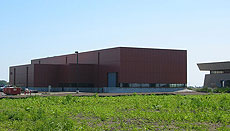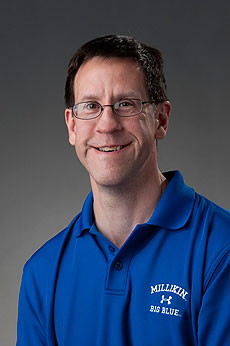|
Have a safe day!
Wednesday, July 13
3:30 p.m.
DIRECTOR'S COFFEE BREAK - 2nd Flr X-Over
4 p.m.
Fermilab Colloquium - One West
Speaker: James Chin-wen Chou, National Institute of Standards and Technology
Title: Al+ Optical Clocks for Fundamental Physics and Geodesy
Thursday, July 14
2 p.m.
LHC Physics Center Topic of the Week Seminar - WH11 Sunrise
Speaker: Daniel Elvira, Fermilab
Title: SUSY Searches II: Elements of a Data Analysis and their Integration in a Search Result
2:30 p.m.
Theoretical Physics Seminar - Curia II
Speaker: Jan Winter, CERN
Title: Developments in ME+PS Merging
3:30 p.m.
DIRECTOR'S COFFEE BREAK - 2nd Flr X-Over
THERE WILL BE NO ACCELERATOR PHYSICS AND TECHNOLOGY SEMINAR TODAY
Click here for NALCAL,
a weekly calendar with links to additional information.
Upcoming conferences
|
|
Wednesday, July 13
- Breakfast: English muffin sandwich
- Cajun-style lentil soup*
- Cajun chicken ranch
- Caribbean jerk pork chops
- Chicken parmesan
- Smoked turkey panini w/ pesto mayo
- Assorted sliced pizza
- Chicken alfredo fettuccine
*Heart healthy option
Wilson Hall Cafe Menu |
|
Wednesday, July 13
Lunch
- Roasted chicken artichoke calzone
- Spiced marinated tomatoes
- Espresso crepe w/ ice cream & dark chocolate sauce
Friday, July 15
Dinner
- Fresh corn blinis with smoked salmon & chive cream
- Crusty pan-seared rib eye steak
- Buttery mashed potatoes
- Vegetable of the season
- Chocolate soufflé with crème anglaise
Chez Leon Menu
Call x3524 to make your reservation.
|
|
NRC report: Proposed underground experiments address questions of “paramount importance”
Proceeding with three physics experiments planned for the Deep Underground Science and Engineering Laboratory (DUSEL) would provide an “exceptional opportunity” for major scientific advances and give the U.S. a leading role in underground science, says a new report by the National Research Council. Although the future of DUSEL is uncertain, each of the proposed experiments addresses at least one crucial unanswered question “upon which the tenets of our understanding of the universe depend,” the report says.
The National Science Foundation and the U.S. Department of Energy have overseen the effort to build DUSEL, a major underground research laboratory to be located in an abandoned mine in Lead, South Dakota. The agencies asked the Research Council to assess the scientific value of the physics experiments proposed for the laboratory and the need to conduct the research in the U.S. given similar science programs in other countries. However, during the course of the study, NSF announced it would no longer be the principal steward for the facility. The two agencies are deciding how to proceed.
“These experiments have the potential to provide breakthrough discoveries in physics that scientists can build upon for decades to come,” said Andrew Lankford, professor of physics and astronomy at the University of California, Irvine, and chair of the committee that wrote the report. “What’s more, performing this research in the U.S. could make our nation a world leader in the expanding field of underground science and have a significant positive impact not only on physics but also other areas of science such as geology and biology.”
Read more
|
Cryomodule Test Facility will help advance SRF technology
 |
Construction of Fermilab’s Cryomodule Test Facility (left) is scheduled for completion later this year. The facility will house radiofrequency systems and a cryogenic plant, crucial components for testing superconducting radio-frequency cavities for the SRF accelerator test facility at the New Muon Lab (right).
Photo: Jerry Leibfritz |
A new building will help keep Fermilab’s next generation of accelerators stay cool. Real cool.
Engineers are getting ready for an upgrade to the cryogenic system for the superconducting radio-frequency accelerator at the New Muon Lab.
Fermilab’s Cryomodule Test Facility (CMTF) will house a new cryogenic plant, which will play an essential supporting role in the laboratory’s future SRF research project.
Construction of the building for this facility, which began in August 2010, will come to an end this fall. Fermilab engineers look forward to installing an energy-efficient superfluid helium cryogenic system in spring 2013.
CMTF will also include radio-frequency power systems and two cryomodule test stands. The test stands will be used to assess cryomodule performance prior to their commissioning. They are being designed in collaboration with engineers in India.
Read more
— Christine Herman
|
Committee champions underground science
From Nature's News Blog, July 11, 2011
A proposed underground laboratory would be an important step in addressing three science questions of “paramount importance”, says a report released today by the National Academies.
The report evaluated the physics experiments that could be performed at the Deep Underground Science and Engineering Laboratory (DUSEL), a cavernous space physicists want dug out nearly 1,500 metres below ground in the abandoned Homestake mine near Lead, South Dakota.
The report, led by Andrew Lankford of the University of California at Irvine, found that three physics experiments would be particularly worthwhile in this quiet space, sheltered from the noisy cosmic ray particles that rain down on the Earth’s surface.
Read more
|
|
Summer is a busy time
Mike Rhoades, chief accounting officer, wrote this week’s column.
 |
| Mike Rhoades |
Summertime brings warm weather, visitors, conferences and a lot of travel to and from our laboratory. The increase in employee and visitor travel during the summer makes it a very busy season for the general accounting group at Fermilab. The group, which processes all travel reimbursements, is working hard to keep up with the challenge. It also handles registration fees, mileage reimbursements, petty cash requests, off-site housing payments and many other payment requests.
The general accounting group is part of the larger Accounting Department in the Finance Section. Like the rest of the Finance Section, we strive to provide the best service to our customers and serve the needs of the Fermilab community, the Fermi Research Alliance and the Department of Energy. Check out the Accounting Department website to find out more about our groups and what they do. On our website you’ll find a contact list for the people in our department, as well as links to forms and schedules and other helpful accounting information. Feel free to contact a group with your questions. On behalf of all the folks in the Accounting Department, I wish you a successful summer and safe travels.
|
ES&H weekly report, July 12
This week's safety report, compiled by the Fermilab ES&H section, includes no recordable incidents and three injuries requiring first-aid treatment: One employee received minor lacerations on his hands after he fell while rushing into Wilson Hall, and two other employees were injured while trying to enter Wilson Hall during Monday's storm. One was blown over by a gust of wind, and another turned her ankle on a curb.
Find the full report here. |
UC Riverside physicists discover new way to produce antimatter-containing atom
From the University of California - Riverside newsroom, July 11, 2011
New method allows positronium to be produced for the first time at a wide range of temperatures and in a controllable way
Physicists at the University of California, Riverside report that they have discovered a new way to create positronium, an exotic and short-lived atom that could help answer what happened to antimatter in the universe and why nature favored matter over antimatter at the universe’s creation.
Positronium is made up of an electron and its antimatter twin, the positron. It has applications in developing more accurate Positron Emission Tomography or PET scans and in fundamental physics research.
Recently, antimatter made headlines when scientists at CERN, the European Organisation for Nuclear Research, trapped antihydrogen atoms for more than 15 minutes. Until then, the presence of antiatoms was recorded for only fractions of a second.
Read more
|
|